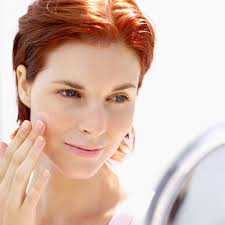January 3rd, 2012 by AmyGivlerMD in Health Tips
3 Comments »


When I was in medical school on my dermatology rotation, we joked that all skin treatments boil down to three decrees: If it’s wet, dry it. If it’s dry, wet it. And if in doubt, use steroids.
Some other time I’ll discuss the “drying” of skin, or the use of steroids (which are not, by the way, the kind of steroids taken illegally by athletes!) Today I’ll cover how to keep the skin “wet” – and some principles of moisturizing.
Skin is our first line of defense against disease. Bacteria, viruses, parasites – dangers lurk everywhere. But our epidermis (the outer layer of our skin) blocks them almost always. When people have inflamed skin, the epidermis becomes disrupted and infectious particles can enter their body.
The key to keeping the epidermis intact is keeping it moist. Now, I’m talking about moisture just below the surface of the skin (within the epidermis), so the outside surface doesn’t feel wet. There are molecules within the epidermis that Read more »
*This blog post was originally published at Making Sense of Medicine*
September 17th, 2011 by CynthiaBaileyMD in Health Tips
No Comments »

 It could be a common dry skin rash called pityriasis alba.
It could be a common dry skin rash called pityriasis alba.
With pityriasis alba, the white patches of fine dry scale are usually located on the sides of the cheeks and the outer side of the upper arm. They’re more likely to occur when activities or weather conditions dry out the skin such as swimming in chlorinated pools or with the temperature extremes of a cold and dry winter. They also show up more when skin is tanned because the scaly patches stay white and contrast against the tanned skin. That means that towards the end of summer, they may well be in full bloom if you live in a dry climate.
What is pityriasis alba?
It’s a subtle form of eczema (also called dermatitis). It’s an unusual rash though because there really isn’t much, if any, inflammation. This means the involved skin doesn’t itch, it just looks funny. Most people mistake it for a fungus, which it isn’t. It’s just a form of dry skin eczema.
What treatments will help get rid of the white spots from pityriasis alba? Read more »
*This blog post was originally published at Dr. Bailey's Skin Care Blog*
February 24th, 2011 by Jeffrey Benabio, M.D. in Better Health Network, Health Tips
No Comments »

 Step-by-step skin care? It’s complicated. You have a cabinet full of toners, creams, and serums and you don’t know what goes on when. Using products in the wrong order could mean you’re not getting the most for your money. Here’s a guide to make it easier for you:
Step-by-step skin care? It’s complicated. You have a cabinet full of toners, creams, and serums and you don’t know what goes on when. Using products in the wrong order could mean you’re not getting the most for your money. Here’s a guide to make it easier for you:
1. Toners
Toners are astringents, which means they contract tissue like pores, making your face feel tighter. They often contain alcohols and are used to remove oil from the skin as well as tightening. Therefore, you should use them first. If you have dry or sensitive skin, however, you might skip them completely because they can make dryness worse.
2. Serums
Serums are liquid cosmetics. They usually have antioxidants or peptides to minimize the day’s damage done to your skin and to give you a more youthful appearance. Serums are applied first so that there’s nothing between their expensive ingredients and your skin. The exceptions are serums that contain silicone or dimethicone. Silicone helps lock moisture in your skin, but it also acts as a barrier hindering anything above it from getting to your skin. Silicone serums should be applied last. Like expensive serums, any prescription medications should also be applied first to ensure that their active ingredients penetrate the skin unhindered. If you have both, then apply the prescription first and the serum second.
3. Eye cream and face cream
Face and eye creams can be simple moisturizers or complex anti-aging products. Eye creams usually have antioxidants to help restore this most delicate skin. If you have one, then apply it before your face cream. Otherwise, by applying your face cream first, you risk rubbing it into your eyes. Once your prescription medications (if any) serums, and eye creams have absorbed, then apply your face cream last. If your serum has silicone or dimethicone, then apply it last, so its protective ingredients are the outermost barrier.
*This blog post was originally published at The Dermatology Blog*
January 8th, 2011 by admin in Better Health Network, Health Tips
No Comments »

This is a guest post from Dr. Jennifer Wider.
**********
Winterize Your Mind And Body
During the winter months, certain health issues may arise that women should have on their radar. From mental health issues like stress, depression and seasonal affective disorder (SAD), to physical concerns like skin care, the winter can certainly pack an extra punch.
Depression peaks during the holiday season, affecting more than 17 million Americans, according to the National Mental Health Association. On average, women are more vulnerable to stress-related illnesses like depression and anxiety than men. One study, conducted by Pacific Health Laboratories, revealed that 44 percent of American women report feeling sad through the holidays compared to 34 percent of American men.
“Depression of any kind is more common in females than males,” explains Greg Murray, M.D., lecturer and clinical psychologist at Swinburne University of Technology in Australia. “A pattern of elevated depression in the winter months is more marked in women than in men.”
There are a host of different reasons why women may be more susceptible to stress during the winter than men. Women tend to be the primary caretakers of the family and often take on the extra burden of the holidays with gift buying, entertaining, and coordinating visits with extended family. For working women, the added responsibilities can be difficult to balance, especially if they are already balancing a family, job, childcare and eldercare duties. Read more »


















